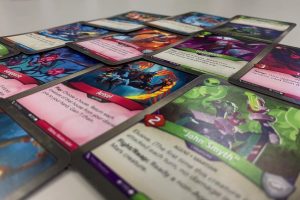
Battles with monsters, aliens and dark creatures, all things that lead players of Keyforge to victory. Players deploy four different types of cards in pursuit of opening the Ancient Vault through the forging of keys.
Keyforge is an up-and-coming trading card game. It offers a new experience for veteran players of similar trading card games, because of the inability for someone to create their own deck.
The goal of the game is to forge three keys, which together open a secret vault.
To start off the game both players draw six cards. This is the only time in the game where the main phase of a turn is different than usual. Once players have decided who goes first, the player going first draws one extra card and only gets to play one card on their first turn.
On a player’s turn there is a certain process to what a person can play at what time. The first phase of a turn is forging a key. To forge a key a player needs to have six ember (the currency of the game) in their stockpile. When someone pays the six ember to forge a key they place it back in the main stockpile.
The next thing that happens on a player’s turn is the option to take cards from their archive. When someone takes cards from their archive they have to take all of the cards in it and are not allowed to pick and choose which ones they take out. The only way to archive a card is with the ability of a card played during a player’s main phase.
After a player chooses to take their archive or not, comes the main play phase. During this part of a turn players choose one of the three houses (symbols on the top left corner of a card) in their deck to use that turn. For the entirety of the turn they may only play cards of the house chosen. Once someone has chosen a house for a turn they cannot switch their decision.
The main phase is the phase where all of the cards are played. During this phase players can play as many cards from the previously chosen house as they want from their hand. Another part of this game is the rule of only being able to use creatures of the chosen house as well, unless a card effect says otherwise.
On a card’s face there are five important aspects, which signify what the card can do, what kind of card it is, and how strong a creature is.
On every card a little sliver of writing, usually next to the name of the card, says what type of card it is. The four card types include creatures, actions, artifacts and upgrades. Each type has unique ways to affect the way a player plays out their turn.
If the writing is on the upper half of the card it is an upgrade. On all other cards the writing is displayed on the lower half of the card. The writing on the cards tells a player what abilities or effects that specific card has on the game.
Upgrades are special cards that give new abilities to creatures already on the board. Whatever the effect on the card says the creature it is played on gains said ability. When a player wants to use an upgrade they place the card under the creature they want to use it on so the new affect from the upgrade is easily seen.
The following podcast features game lover Andrew Moore, ’21, long time collector of games similar to Keyforge, who shares his favorite parts of the game.
Finally is the play of these cards. During the main phase a player can play any of the cards in their hand, or use creatures on the field, according to what house they chose. Creatures have three ways they can be used. First is attacking the other player’s creatures, second is called reaping with a creature, and third is using a creatures action if they have one.
Long time trading card game enthusiast Andrew Moore, ‘21, expresses why he enjoys Keyforge and how it is similar to other games he has played.
“I really like how familiar playing Keyforge is from my previous experience playing card games like Yugioh and Pokemon. Summoning and card effects bring me back to things like tournaments or simple duels against friends. I also liked the newness and different objectives of Keyforge. Obtaining keys or playing defense. Overall, I was super happy with the game, learning a bit and playing a little as well.”
When attacking with a creature a player choses what creature they want to attack with and what creature they want to attack. Once they have decided which one they are attacking both players look at the red circles on the creature cards. The numbers in these are the power of the creatures. Their power is both their attack power and health.
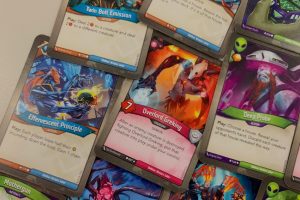
If a creature with three power attacked a creature with four power the first creature would die and go to the graveyard and the second would have three damage counters on it because of the attack of the other one.
After a battle, if the creature who survived had writing in their description that stated “Fight:…..” this means that ability is activated after the battle if the creature survives.
Similar to this is when a creature’s description says “Reap:…..” ,which means after a creature reaps that specific ability activates. These affects usually impact other creatures already in play.
Reaping with a creature is an alternative action a creature can take once per turn. When a creature reaps the owner of the card gains one ember to their stockpile and turns the creature sideways to show the card has been used.
Some cards, mainly action cards, allow the player who played it to gain ember, which is the way to create keys. On the side of some action, upgrade and artifact cards there will be yellow gems which signifies when the card is played the person who played it gains ember equal to how many gems were on the card.
Cohl Obwald can be reached via email or Twitter.
For another game review read, Spicy Uno: A new twist to an old favorite. For more articles read, Stuffed Animal Drive To Benefit Valley Children’s Hospital.



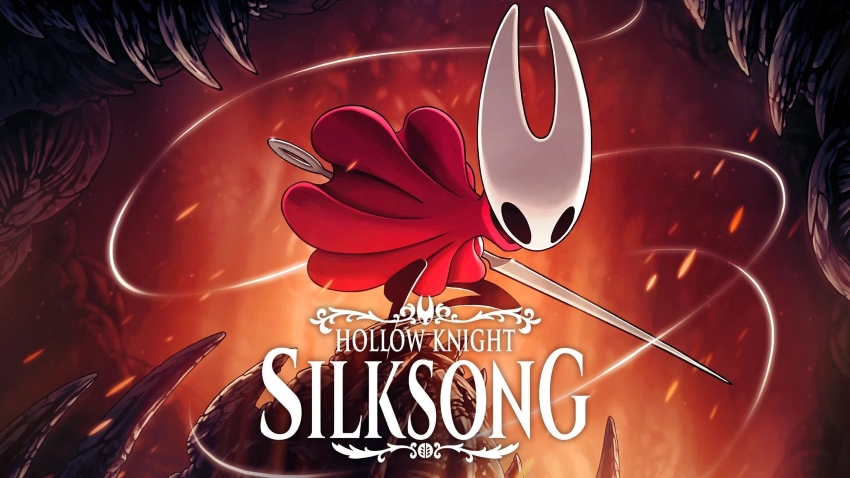

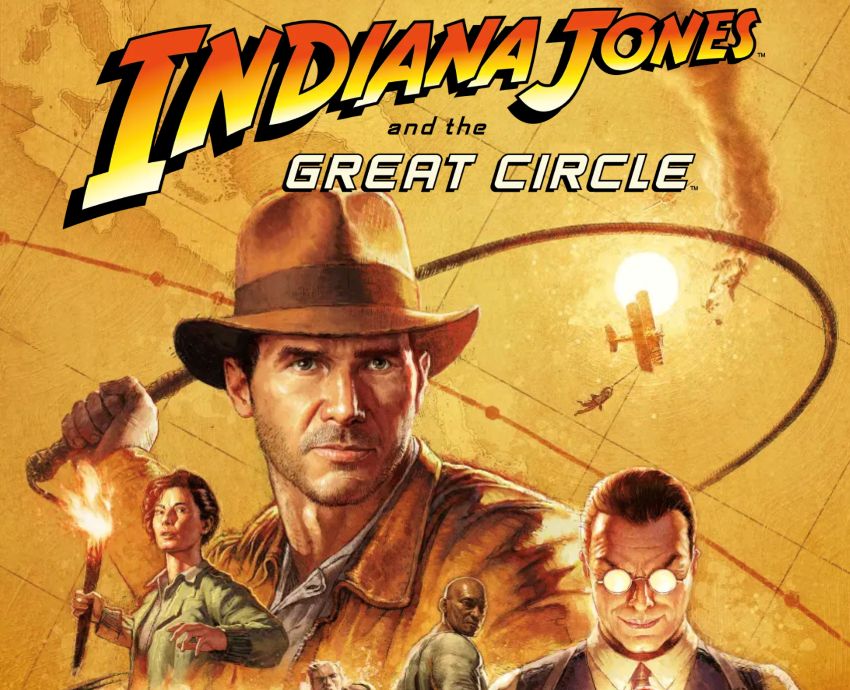


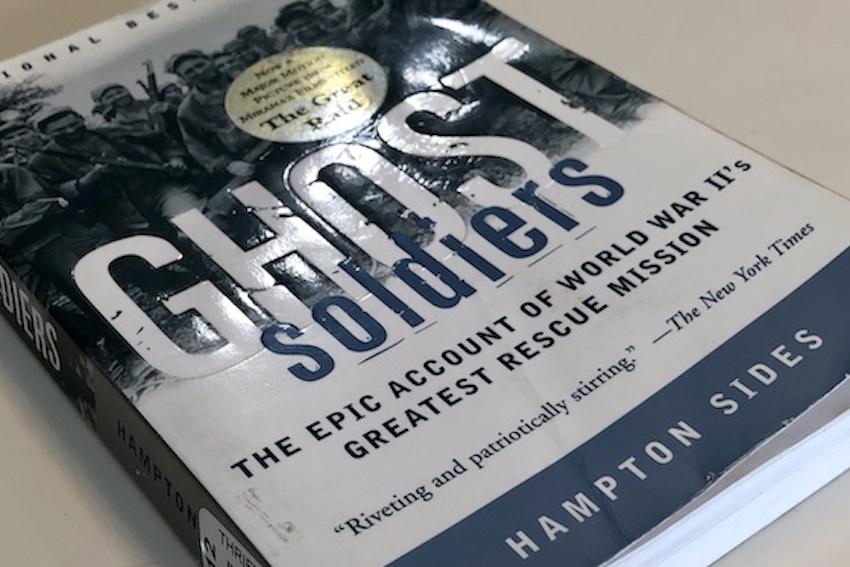

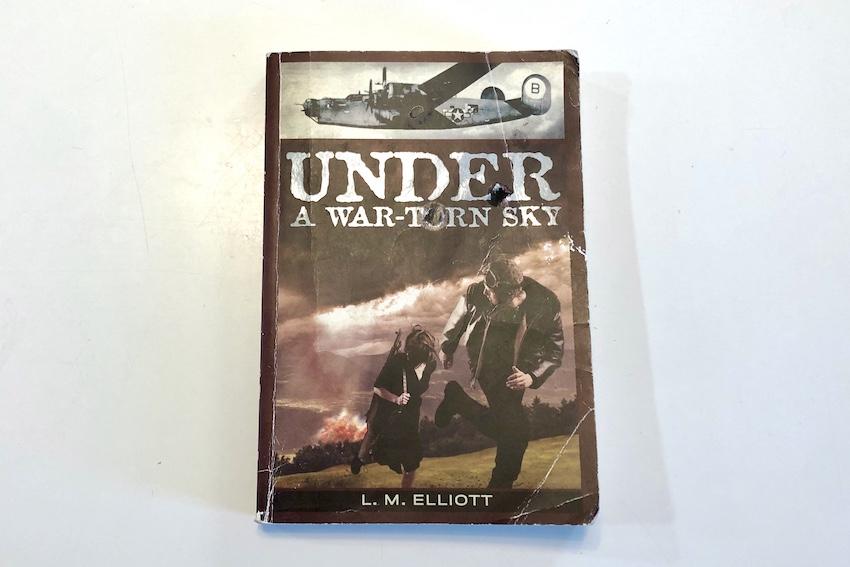
Gabriel Ramirez • Dec 6, 2018 at 4:44 pm
Thanks for the breakdown, reminds me of my pokemon days. Sounds like a fun way to get back into the world of trading card games!